The six meridians that begin or end in the lower body are of most interest to Yin Yoga practitioners. These are the lines affected the most by the yin asanas. They are the Liver, Gall Bladder, Kidney, Urinary Bladder, Spleen, and Stomach meridians.
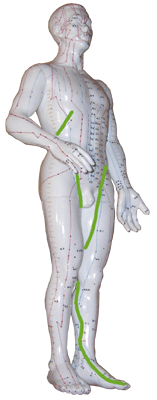 The Liver Meridian
The Liver Meridian
The Liver meridian begins at the inside of the nail of the big toe and runs along the top of the foot. It climbs the front of the ankle and then runs up the inside (medial) part of the leg (running just beneath the Spleen meridian) until it reaches the pubic area. From here it curves around the external genitalia and goes into the lower abdomen [1] where it enters into the liver and the gall bladder. Rising higher, it branches in several directions, with one branch connecting to the Lung meridian. Rising still higher, the Liver meridian follows the throat and connects with the eyes before branching again. One branch reaches down across the cheeks and circles the lips, while a higher branch goes across the forehead to the crown where it links with the Governor Vessel meridian.
Lower back pain, abdominal pain, or mental disturbances may be a sign of disharmony of the Liver. Frequent or unreasonable anger or irritation may also be a sign of dysfunction here.
 The Gall Bladder Meridian
The Gall Bladder Meridian
The Gall Bladder meridian begins at the outer corner of the eye (close to the Liver meridian, which passes through the center of the eye) and immediately branches into two lines. A main branch remains on the surface and winds back and forth across the side of the head and above the ear, before turning downward along the side of the neck. After following the top of the shoulder, it passes under the arm and zigzags along the side of the ribs to the hips. The other branch goes inside the cheek and descends to the liver and gall bladder. From there it descends farther and emerges in time to rejoin the first branch at the front of the hip. The single line then descends, running along the outside (lateral) thigh and knee until it reaches the ankle. It runs across the top of the foot until it reaches the fourth toe; however, another branch leaves at the ankle to run across the top of the foot and join the Liver meridian at the big toe.
Headache, blurred vision, and pains along the side of the body including the eyes, ears, and throat may be an indication of problems with the Gall Bladder meridian.
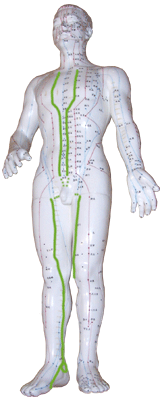 The Kidney Meridian
The Kidney Meridian
The Kidney meridian begins at the outside of the little toe and immediately goes under the sole of the foot. It follows the arch, makes a circle around the inner ankle and then it runs through the heel, and comes up the inmost (medial) side of the leg (just beneath the Liver meridian) and into the tailbone. It follows the spine to the kidney and then branches. One branch heads to the Urinary Bladder, where it comes back to the surface of the abdomen and up the chest, ending at the clavicle. The other branch touches the liver and diaphragm and moves up through the lungs and throat until it ends beside the root of the tongue.
Disharmony of the Kidney meridian is suggested by gynecological problems, genital disorders, and problems in the kidneys, lungs, and throat. Examples may include impotence, frequent urination, and weakness in the lower limbs. Emotional problems may also occur related to anxiety and fear.
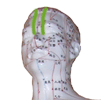 The Urinary Bladder Meridian
The Urinary Bladder Meridian
Like the Gall Bladder meridian, the Urinary Bladder meridian also begins at the eye. The Urinary Bladder line starts at the inner eye and then goes up, across the forehead, to the crown. One branch splits here, enters the brain, and then reemerges at the scapula and runs just inside the line of the scapula down the 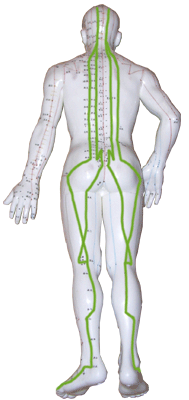 spine to the buttocks, where it reenters the body and runs to the urinary bladder and the kidney. The second branch from the crown flows down the back of the neck and shoulder and runs just outside and parallel to the first branch. This branch continues down the back of the buttocks and legs, circles the outer ankle, runs along the outer edge of the foot, and ends in the small toe where the Kidney meridian begins. Dr. Motoyama believes that the ida and pingala nadis correspond to the Urinary Bladder meridians, because they run along either side of the spine.
spine to the buttocks, where it reenters the body and runs to the urinary bladder and the kidney. The second branch from the crown flows down the back of the neck and shoulder and runs just outside and parallel to the first branch. This branch continues down the back of the buttocks and legs, circles the outer ankle, runs along the outer edge of the foot, and ends in the small toe where the Kidney meridian begins. Dr. Motoyama believes that the ida and pingala nadis correspond to the Urinary Bladder meridians, because they run along either side of the spine.
Signs of disharmony in the Urinary Bladder may include backaches, headaches, an inability to urinate, mental problems, and disease of the lower limbs.
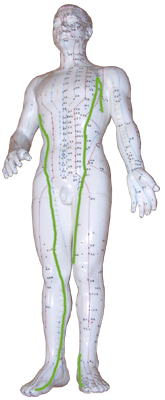 The Spleen Meridian
The Spleen Meridian
Starting at the inside of the big toe, the Spleen meridian runs along the inside of the foot, then turns and runs up the inside of the ankle and the shin. It runs just in front of the Liver meridian and enters the abdominal cavity, just above the pubic bone. It connects to the spleen and then the stomach, where it branches. The main branch comes to the surface and runs up the chest to the throat where it again enters the body, going to the root of the tongue, where it spreads out. The second branch remains internal and reaches the heart, connecting to the Heart meridian.
Indications of Spleen disharmony include stomach problems, flatulence, vomiting, and bloating. Unreasonable worry may also arise.
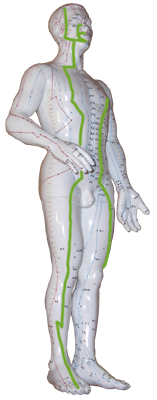 The Stomach
The Stomach
Beginning at the side of the nose, the Stomach meridian rises to the corner of the eye (where it connects to the Urinary Bladder meridian) before descending along the side of the nose, to enter the upper gum, and follow the outer lips to the lower jaw, toward the joint of the jaw. It branches here with one branch ascending along the front of the ear to the forehead. The other branch descends through the body to the diaphragm, and runs to the stomach and spleen. A third branch emerges from the lower jaw and runs across the outside of the body, crossing the chest and belly, until it terminates in the groin.
The line that runs through the stomach reconnects with this third branch and runs downward along the front of the leg, reaching the top of the foot. Here it splits again, with the main branch ending in the outside (lateral) tip of the second toe. The other branch reaches the inner (medial) side of the big toe where it meets the Spleen meridian. Just below the knee an additional branch splits off and runs to the lateral side of the third toe.
Like the Spleen meridian, problems with the Stomach meridian may be indicated by abdominal problems such as bloating, vomiting, pain in any of the areas the meridian passes through (mouth, nose, teeth, etc.), as well as mental problems.
(Next: The Upper Body Meridians )
